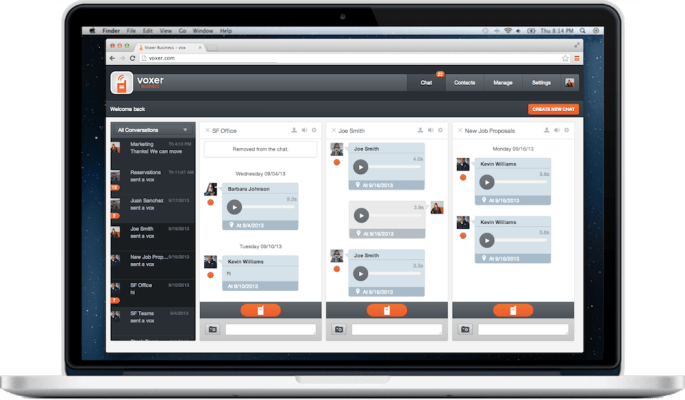Voxer, the mobile messaging app that started out 2013 with a little notoriety (thanks to Facebook cutting off its API access), is today taking the next step in its transformation into a paid enterprise push-to-talk and chat product: the company is launching Voxer for Web, a version of the service that links up the company’s paid Voxer for Business iOS and Android apps with a desktop version.
Priced as part of the company’s bigger Voxer for Business service — rates for that are currently $4.95/user/month but are going up to $9.95/user/month January 1, 2014 for sign-ups after then — the web version will help Voxer transform from one that can be used as a person-to-person communication system into a more unified product, to also include those who are in a stationary place and need to communicate with many workers at once. Think dispatchers for taxi or other delivery servicees. (As for the price hike, Voxer also says that for those who sign up before the end of December, they will get the lower pricing option applied until October 2014).
Voxer for Web essentially takes several of the features from the company’s existing mobile apps for business users and extends them to desktop computers, with the ability to push live and messaged audio, sending images and text messages and chat. Added features include the ability to have multiple chats open on a single screen; and voice messages, texts and images sent from a whole team. Users can also listen to multiple chats in live mode — similar to what you get in lower-quality existing dispatch services.
Itamar Kandel, COO at Voxer, tells us that the company has gone for a web version in response to requests from businesses. “We’ve heard from customers across a variety of industries that need to enable their mobile workforces and desk workers to collaborate,” he said. “Voxer for Web addresses this by providing a unified experience while also including unique features that will enable administrators and dispatchers to monitor multiple conversations, people or teams – all from a computer.”
He notes that the idea is that this not just signifies an increase in functionality, but also in terms of the kinds of businesses that Voxer is targeting. “Our vision is that mobile will be for the moving workforce, whereas desktop is ideal for businesses that have large workforces that vox and need to communicate quickly with a central person, such as a dispatcher,” he said. “By adding the ability to send messages from a desktop, we have increased our addressable market tenfold, and can now service the communication needs of not just mobile employees but also the needs of the entire organization. Voxer for Web will serve as the connective tissue between the mobile and stationary workforces.”
Voxer’s consumer product — which stands apart from other messaging apps like WhatsApp for being primarily focused on voice-based exchanges — has had tens of millions of downloads, with a particular surge in 2012, the same year it raised a large $30 million round.
The company today is not revealing how many enterprises have signed up to Voxer for Business (we’re asking). It’s unlikely to be a volume play like the consumer product, but it represents a couple of different and important evolutions for the company. The first and most obvious is the startup’s move to targeting a paying audience with its products, and along with that a push to make Voxer into an enterprise-class company, complete with stronger service levels, security and a roll-out of features that are needed and demanded by those paying customers.
The second is how Voxer has become, yes, one of the many to tap into the bigger consumerization trend, taking a product originally created for average consumers and applying it to the enterprise market — but it is one with a twist. Voxer is also a sign of how in fact even consumer products can come out of enterprise beginnings: founder Tom Katis apparently first came up with the idea out of his own experiences as a communications specialist with the military in Afghanistan.
In making the switch to business users, Voxer is not exactly entering unchartered territory. It competes against those services also with origins in consumer apps from the likes of Sprint, with its Nextel push-to-talk service.
Perhaps more importantly for Voxer, there are a number of other messaging services and dispatch messaging services that are specifically aiming at the same market it is. Take taxi services, one of Voxer’s key targets. (In a press release announcing the new web version, it quotes Tom Brennan, owner of Future Cab: “Voxer has played a central role in my company, allowing my team to constantly be in touch with each other and with me.” He lives in Virginia Beach and operates a service in New York from there, apparently.) There are dozens of companies out there already, some working on legacy systems that require special in-car equipment; but many more riding on the explosion of mobile networks and mobile handsets to run services. Competitors include T Dispatch and PC Dispatch (which I’m guessing are close rivals), Digital Dispatch, TaxiCaller, AutoCab and many more.
Whether Voxer’s additional functionality, letting users send pictures and more, its strong brand recognition on the consumer side, and Katis’ connections to VC money and subsequent networks, will be enough to set it apart and win new customers, will be worth watching.
Voxer has raised some $30 million to date with backers including Institutional Venture Partners, Intel Capital, SV Angel, TC-founder Michael Arrington’s CrunchFund, Chris Dixon, Roger McNamee, Windcrest Partners and Webb Investment Network.
